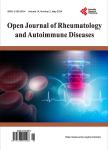A 10-Year Saudi Experience of Using Adalimumab in Treating Juvenile Idiopathic Arthritis
A 10-Year Saudi Experience of Using Adalimumab in Treating Juvenile Idiopathic Arthritis作者机构:Department of Pediatrics King Abdulaziz University Hospital Jeddah KSA
出 版 物:《Open Journal of Rheumatology and Autoimmune Diseases》 (风湿病与自身免疫疾病期刊(英文))
年 卷 期:2019年第9卷第2期
页 面:42-56页
学科分类:1002[医学-临床医学] 100214[医学-肿瘤学] 10[医学]
主 题:Adalimumab Juvenile Idiopathic Arthritis Anti-TNFα
摘 要:Background: Traditionally, management of Juvenile Idiopathic Arthritis (JIA) involves use of non-steroidal anti-inflammatory drugs (NSAIDS) or disease-modifying anti-rheumatic drugs (DMARDs), such as methotrexate (MTX) or sulfasalazine;or steroids. However, in several cases, a low therapeutic response or important side effects is encountered. This study reports our experience in using adalimumab in JIA patients by assessing the efficacy and safety of this treatment in this category of patients. Methods: A retrospective study was conducted among 38 patients with JIA at the Pediatric Department, King Abdulaziz Univesrity Hospital, Jeddah, Saudi Arabia, in the period January 2005-March 2016. Patients’ records were reviewed and relevant demographic and clinical data were collected. Data were analyzed using SPSS version 21 and represented using tables. Results: The 38 patients were distributed as 11 (28.9%) males and 27 (71.1%) females;mean ± SD age was 11.91 ± 4.54 (range = 3 - 19) years. Mean ± SD (range) disease duration was 3.26 ± 2.52 (0 - 12) years and most frequent diagnoses included polyarticular rheumatoid factor (RF) negative form 12 (31.6%), followed by systemic and oligoarticular JIA with 9 (23.7%) cases each. Before adalimumab, fever was present in 13 (34.2%) cases, followed by rash in 8 (21.0%) cases;while 21 (55.3%) were asymptomatic. Thirty-one (81.6%) were in failure of MTX, 19 (50%) of steroids, 7 (18.4%) of NSAIDS and 3 (7.9%) had had intraarticular injections. Biologically, ANA, RF and anti-CCP were positive in 22 (57.9%), 8 (21.1%) and 4 (10.5%) of the cases, respectively. Uveitis was present in 11 (28.9%) of the patients. Analysis of adalimumab efficacy showed 10 (52.6%) cases of complete remission, 9 (23.7%) of partial remission and 9 (23.7%) other where treatment was discontinued. Major adverse effects included local pain (4 [10.5%]), new onset uveitis (1 [2.6%]) and rash (1 [2.6%]), responsible of 1case of treatment discontinuation. Predictors fo



